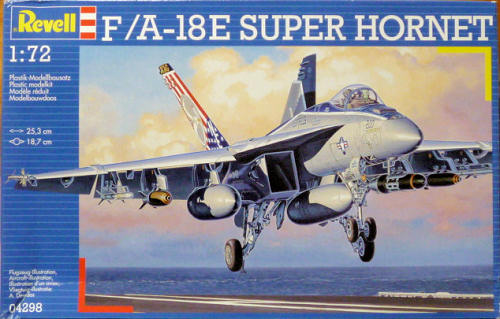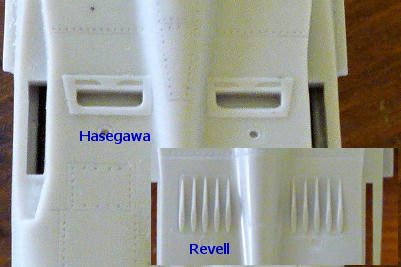
Revell 1/72 F-18E Super Hornet
| KIT #: | 04298 |
| PRICE: | $19.95 MSRP |
| DECALS: | Two options: VFA-105/137 |
| REVIEWER: | Shervin Shambayata |
| NOTES: | New Mold kit |

| HISTORY |
F/A-18E/F Super
Hornet is now the primary tactical aircraft of the
Although F/A-18E/F
addresses some of the most major problems with F/A-18 (namely, short range,
small loads and huge radar cross-section) it is still not as capable a fighter
as the F-14 which it replaced. Not only does the Super Hornet not carry the
deadly
First flown in 1995, Super Hornets became operational in 1999 and by 2006 they had replaced F-14’s in squadron service. The US Navy employs both the single seat F/A-18E and the twin seat F/A-18F with F/A-18E geared more towards replacing F/A-18C’s for strike and light attack duties and the F/A-18F geared more towards fleet air defense and interdiction missions.
| THE KIT |
 To the best of my
knowledge this is the third kit of F/A-18E in 1/72. The first offering was the
rather inaccurate Italeri kit with its inaccurate dorsal air brake that does not
exist on the actual aircraft. Next was the Hasegawa kit that was universally
hailed as a great kit (more on that later). Now we have this Revell kit.
To the best of my
knowledge this is the third kit of F/A-18E in 1/72. The first offering was the
rather inaccurate Italeri kit with its inaccurate dorsal air brake that does not
exist on the actual aircraft. Next was the Hasegawa kit that was universally
hailed as a great kit (more on that later). Now we have this Revell kit.
The Revell kit
comes in four darker gray sprues (almost the same shade as the Academy kits) and
two clear sprues (one holding the HUD and the windscreen, the other the canopy).
Detailing is generally crisp but on my kit I had a little flash around the
auxiliary tanks. The parts breakdown is very similar to the Hasegawa offering
with a two-seater bound to arrive in the near future. There are differences,
however, between the two kits:
The cockpit on the
Revell kit has raised instrument detail and a relatively detailed ejection seat.
The Hasegawa kit uses decals for the instruments and a basic shape for the bang
seat.
The Revell kit
offers full intake trunks but the Hasegawa kit does not.
 The Revell kit
landing gear doors are in one piece and need to be cut out for them to be
displayed open.
The Revell kit
landing gear doors are in one piece and need to be cut out for them to be
displayed open.
The Revell kit has
the newer model heat exchanger vents between the tails whereas the Hasegawa has
the older version. Since both types are currently in use and some of the older
Super Hornets are being upgraded, it is important to check your references.
The tail planes on
the Revell kit are molded as one piece connected by single shaft whereas on the
Hasegawa they are separate. I believe on the real aircraft the tail planes have
differential pitch so the Hasegawa kit is more accurate but since on the ground
the tail planes are usually in the same non-neutral position, the Revell maybe
more practical.
The wings on the
Hasegawa kit are separate from the main fuselage whereas on the Revell kit most
of the wings up to the hinge for the folding wing tips are part of the rear
fuselage halves. Needless to say, this makes the job of creating folded wings
for the kit by the aftermarket crowd much easier.
The fuel tanks for
the Revell kit are different from those for the Hasegawa. I have to check photos
to see which is more accurate.
 The shape of the
air intakes are different for the Revell kit with their outside being more flat
than the Hasegawa kit. I do not know which one is more accurate but from the
photos I think Revell may have the better shape.
The shape of the
air intakes are different for the Revell kit with their outside being more flat
than the Hasegawa kit. I do not know which one is more accurate but from the
photos I think Revell may have the better shape.
I have not made
measurements but at first glance the nose of the Revell kit looks slightly
smaller. I have to build the aircraft to see if this is indeed the case.
The Revell kit has
a lot more weapons. Hasegawa kit comes with only a pair of
One thing that
Revell kit has in its favor is the lack of ejector pin marks on pylons, weapons
and gear doors. Hasegawa kit is festooned with these marks. On the other hand,
the Hasegawa kit has a slide molded canopy that has the correct bulbous shape.
The kits
instructions are typical of Revell AG with multiple pictorial steps and Revell
color call outs. Fortunately, for the exterior, the colors are also given in FS
numbers. For the interior colors, however, you need to check your references
with main interior color being FS36231 dark gull gray with black bang seat
frames.
The decals are
provided for two aircraft. First is VFA-137 Kestrels
| CONCLUSIONS |
I am not sure how
this kit builds but given the recent offerings from Revell I think it should be
a fine build and certainly more fun than the Hasegawa kit because there are no
ejector pin marks that need to be filled. On the other hand the Hasegawa kit has
better surface detailing to my eyes. I am not an expert in the shape of the
Super Hornet but to my eyes, the two kits have different shapes. Currently (June
2009), the latest Hasegawa boxing of F/A-18E has an MSRP of $38.95 while this
kit retails at about $20.00. Given this, the better cockpit, the ordnance and
the intake trunking, I think this kit has an advantage over the Hasegawa kit
barring some “fatal” shape issues.
June 2009
If you would like your product reviewed fairly and quickly, please contact me or see other details in the Note to Contributors.